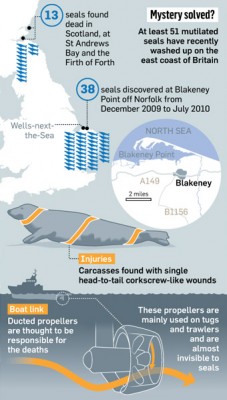| Wind Watch is a registered educational charity, founded in 2005. |
Wind farm link to butchered seals
Credit: Mark Macaskill, Sunday Times, www.thesundaytimes.co.uk 22 August 2010 ~~
Scientists investigating the deaths of dozens of seals whose mutilated carcasses have washed up at a beauty spot believe the construction of an offshore windfarm is probably to blame.
They believe the seals were sucked into “hidden” propellers on boats travelling to and from the windfarm site off the Norfolk coast and ejected with corkscrew-like injuries.
At least 38 carcasses have been found near the village of Blakeney, west of Cromer, in the past eight months. The seals had been killed by a deep, clean cut that began at the neck and spiralled around the body.
The grisly find had baffled marine experts and conservation groups.
However, an investigation involving Norfolk police, the RSPCA and the Sea Mammal Research Unit (SMRU) at St Andrews University, Fife, has now established that building work at the harbour in nearby Wells-next-the-Sea started last December, when dead seals first began to appear along the coast. The work involved the creation of a pontoon and jetty, allowing equipment and turbine parts to be transported to the Sheringham Shoal windfarm, which began construction in April about 12 miles off the coast.
The windfarm, run by Statoil, a Norwegian company, will supply enough green energy to power 220,000 British homes from next year.
It is thought the seals have fallen victim to ducted propellers, which are common on vessels such as trawlers and tugboats as they provide greater fuel efficiency at low speeds.
Unlike open propellers, they are surrounded by a metal casing which makes them virtually invisible to marine life. “The wound looks as if the animal is being hit with something with a right-angled edge but the animal is rotating against that blade, leading to tissue damage, massive blood loss and death,” said Dr David Thompson, who is leading inquiries at the SMRU.
“It’s gone in head first and we have to wonder why active, agile and intellectual animals are swimming into it.
“We think it’s probably a ducted propeller device. It’s not an ordinary, open propeller because of the characteristics of the wound.
“Ducted propellers are not a new technology, but they’re certainly becoming more common in ships and boats because they are more efficient at slow speeds.”
Thompson added: “We don’t think the deaths are being caused by windfarms per se, but there may be a connection with traffic associated with wind farms.”
A source close to the investigation said: “Work at Wells harbour started in December and might explain why seals were being killed over the winter.”
The dead seals have become so frequent that the National Trust has sent out early-morning patrols to clear carcasses before children arrive on the beaches. The area is home to a 500-strong colony of grey and common seals – both protected species.
Seven seals with identical injuries to those seen in Norfolk have been reported in St Andrews Bay and the Firth of Forth in Scotland. Six further incidents, which took place in 2008 and 2009 in the same areas, have also been recorded. One theory is that these seals were caught in increasingly busy lanes of maritime traffic, which include vessels servicing offshore oil installations.
Researchers in Canada, where similar injuries were discovered in the Gulf of St Lawrence a decade ago, blamed Greenland sharks, which can grow up to 20ft in length.
Shark attacks have been dismissed as the cause of the latest spate of injuries in British waters because of the absence of teeth marks.
Statoil said: “We are cooperating fully with the police. We have carried out our own investigation where we checked all the equipment operating on our site. We concluded that, to our knowledge, none of our equipment could be associated with the seal deaths.”
This article is the work of the source indicated. Any opinions expressed in it are not necessarily those of National Wind Watch.
The copyright of this article resides with the author or publisher indicated. As part of its noncommercial educational effort to present the environmental, social, scientific, and economic issues of large-scale wind power development to a global audience seeking such information, National Wind Watch endeavors to observe “fair use” as provided for in section 107 of U.S. Copyright Law and similar “fair dealing” provisions of the copyright laws of other nations. Send requests to excerpt, general inquiries, and comments via e-mail.
| Wind Watch relies entirely on User Contributions |
 (via Stripe) |
 (via Paypal) |
Share:


